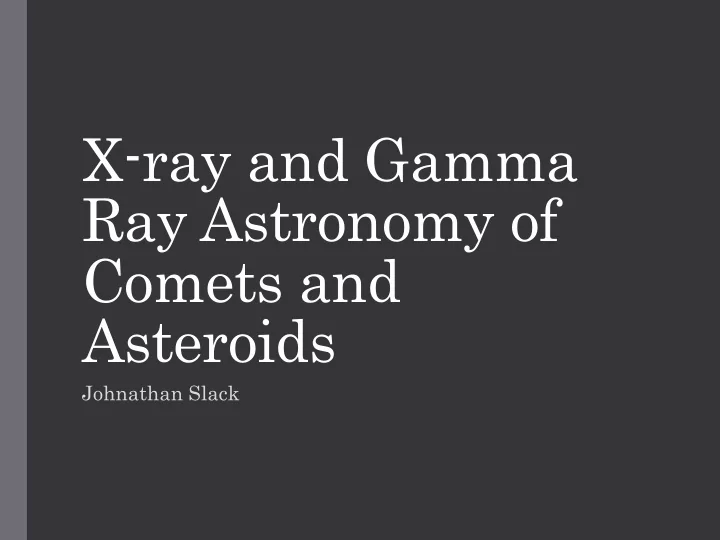

X-ray and Gamma Ray Astronomy of Comets and Asteroids Johnathan Slack
X-ray Astronomy History • Dozens of missions since the 1960’s involved X-ray detectors • The first dedicated telescope was Uhuru which was launched in 1970. Consisted of two proportionality counters at the end of a viewing pipe (2-20 keV) • The first X-ray imagining satellite was Einstein (1978). Introduced grazing mirrors Imaging proportional counter High resolution imager Solid state spectrometer Crystal spectrometer
Cometary X-rays • First satellite to detect was ROSAT (1990) High resolution imager at 0.1-2.5 keV range with 2 arcsecond resolution Proportional counter Wide field camera for UV light • The comet Hyakutake 100x more luminous than predicted (~10^15 ergs/sec) 3rd brightest X-ray source in the solar system Varied with time Crescent shaped distribution A lot of debate on what caused these features (Bremsstrahlung, K-shell ionization, SWCX, etc)
Chandra
The most advanced X-ray telescope in use today Almost 14 meters in length Operates in the 0.06-10 keV range Highly eccentric 64 hour orbit for long exposures
Chandra’s mirrors Two sets of four nested mirrors • Deflects incoming x-rays about 1 degree for • each mirror Polished to within a few atoms thickness • Iridium coated for deflection purposes •
Advanced Imaging CCD Spectrometer (ACIS) Two sets of detectors. A group of four CCD’s for imaging and a row of six CCD’s for imaging and spectroscopy. Each CCD has 1024x1024 pixels Collected electrons are passed down the line to a serial readout
High Resolution Camera (HRC) • Two sets of detectors makes up the HRC. Both are microchannel plate detectors (MCP). One for direct imagining, one for spectroscopy with the transmission grating. Input MCP is coated with CsI to enhance photoemission Cascade is dumped onto position sensitive electron detector Cascade effect leaves a distinct physical distribution for X-rays • Imager has largest FOV of 30’x30’ and energy range of 0.06 -10 keV.
Low and High Energy Transmission Gratings • Low energy transmission grating (LETG) Operates primarily in the 0.07-0.15 keV Can be operated at 0.25-4.13 keV but with reduced resolving power Paired with either HRC or ACIS depending on source (harder vs. softer spectra) • High energy transmission grating (HETG) Operates in the 0.4-10 keV Can be used to measure Doppler velocities of plasmas as low as 50 m/s Most often paired with the ACIS
Chandra’s Observations Chandra clearly showed the temporal, morphological, luminous and spectrum characteristics that settled the debate. Solar wind charge exchange was the only model to explain these features.
Solar wind charge exchange (SWCX) • Heavy ions in the solar wind exchange charges with neutral targets in the coma. • Dominated by single charge exchange in the spectrum 𝑃 �� + 𝐼 → 𝑃 �� ∗ + 𝐼 � Example: Excited Oxygen will always emit an X-ray on its way to the ground state • Variety of heavy ions causes a rich spectrum due to the numerous states that can be exchanged. (O 7+ , O 6+ , C 6+ , C 5+ , N 6+ , Ne 8+ , Si 9+ , Fe 12+ ,etc.) • Emission rate depends on both ion and neutral species 𝑄 ���� 𝒔 = 𝑜 �� 𝒔 𝑜 � 𝒔 < > 𝑔 ��� 𝜏 ��� • Observed in comets, Mars halo, heliosphere background, etc. • Can be used to measure the density and composition of the solar wind in difficult to reach locations
X-ray spectroscopy of asteroids • Very little has been done because their signals are so weak • Cannot image from earth orbiting satellites • Must get very close with a detector to gather any useful data • No atmosphere means no SWCX • Cannot be used as mobile heliosphere laboratories like comets • There have only been two missions
Hayabusa and NEAR Shoemaker The only missions to successfully collect data from asteroids in the X-ray spectrum. Hayabusa (2003) Designed to collect samples X-ray spectrometer on the orbiter (CCD based of 0.7-10 keV) Detected X-ray fluorescence on the surface NEAR Shoemaker (1996) Designed as an orbiter only X-ray spectrometer (Three gas-filled proportional counters of 1-10 keV) Orbited Eros for a full year then landed on the surface anyway
Gamma rays of comets and asteroids Only one mission has taken gamma ray data, NEAR Shoemaker. • Combination X-ray/gamma ray spectrometer (XGRS) • Gamma ray detector operated in the 0.3-10 MeV range After NEAR’s landing on Eros the gamma ray detector took data for 7 days. This data was far better than all of the previous data taken from orbit.
What’s next? The X-ray Surveyor • Proposed successor to Chandra • Strong focus on photon collection to improve imaging New mirror assembly to drastically increase photon throughput Build a series of modules using slumped glass Possibly also use adjustable optics and/or differential deposition
References Arai, T., Okada, T., Yamamoto, Y., Ogawa, K., Shirai, K., & Kato, M. (n.d.). Sulfur abundance of asteroid 25143 Itokawa observed by X-ray fluorescence spectrometer onboard Hayabusa. Earth, Planets and Space Earth Planet Sp, 21-31. Bhardwaj, A. (n.d.). [1012.1088] X-rays from solar system objects. Submitted December 6, 2010, from http://arxiv.org/abs/1012.1088 Okada, T., Kato, M., Fujimura, A., Tsunemi, H., & Kitamoto, S. (n.d.). X-ray fluorescence spectrometer onboard Muses-C. Advances in Space Research, 345-348. Paerels, F., & Kahn, S. (n.d.). High-Resolution X-Ray Spectroscopy with Chandra and XMM-Newton. Annual Review of Astronomy and Astrophysics Annu. Rev. Astro. Astrophys., 291-342. Trombka, J. (2000). The Elemental Composition of Asteroid 433 Eros: Results of the NEAR-Shoemaker X-ray Spectrometer. Science, 2101-2105. Weisskopf, M. (n.d.). [1505.00814] Beyond Chandra. Submitted May 4, 2015, from http://arxiv.org/abs/1505.00814 Chandra X-ray Observatory - NASA's flagship X-ray telescope. (n.d.). Retrieved October 10, 2015, from http://chandra.harvard.edu/ Chandra Instruments and Calibration. (n.d.). Retrieved November 17, 2015, from http://cxc.harvard.edu/cal/ National Aeronautics and Space Administration. (n.d.). Retrieved October 20, 2015, from http://heasarc.gsfc.nasa.gov/docs/uhuru/uhuru.html National Aeronautics and Space Administration. (n.d.). Retrieved October 20, 2015, from http://heasarc.gsfc.nasa.gov/docs/einstein/heao2.html Near Earth Asteroid Rendezvous Mission. (n.d.). Retrieved October 22, 2015, from http://near.jhuapl.edu/
Recommend
More recommend